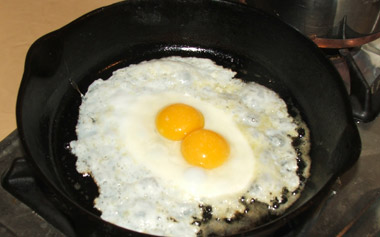If, for you, nothing beats a couple of hours’ alone time in the kitchen, whisking egg whites into fluffy peaks of meringue, putting together the perfect family roast or concocting a new recipe for the creamiest of carbonaras, then you might be interested to know that the pots and pans you cook with may be having a negative impact on your health.
Since it first went on sale in the 1950s, non-stick cookware (the best-known brand of which is Teflon) has taken over our kitchens. We bet there’s a non-stick pan or two in your cupboard, right? And why not? Non-stick is lightweight, practical and makes washing up a doddle, so what’s not to like?
Despite its popularity, non-stick has found itself in a rather, er, sticky situation over safety. Made from a lining called PTFE (polytetrafluoroethylene), this super-convenient cookware has come under fire after studies claimed it can cause the release of toxic fumes and gases, a result of the breakdown of particles in the lining. These emissions have been linked to symptoms such as headaches, fever and flu, and certain hormonal disorders. What’s the truth behind the claims?
DuPont, the biggest manufacturer of Teflon, claims that it maintains its products’ safety through “quality testing,” and the U.S. Food and Drug Administration (FDA) has found Teflon coatings “acceptable for conventional kitchen use.” But what about research that indicates the opposite is true? Studies by West Virginia University suggest that PFOA, a chemical used in Teflon, has harmful effects on the immune system, liver and thyroid, and raises cholesterol in children, while John Hopkins University linked the same chemical to a small decrease in the weight of newborns.
Darren Murley of GreenPan, an eco-friendly cookware manufacturer that uses a ceramic Thermolon non-stick lining, says: “The invention of non-stick coatings revolutionized the way we cooked from a health point of view. Suddenly we could cook with less oil, as the food simply slid around the pan! However, the basic technology of non-stick coatings has remained the same to this day. The PTFE coating itself is made from a plastic synthetic substance which starts to decompose at temperatures above 260 C/500 F. So what are the alternatives to PTFE, and which serve up the safest food?
Stainless Steel
Pros: Favored by professional chefs around the world, stainless steel cookware gets top marks for durability and dishwasher-friendly properties. It has also been deemed extremely safe and no studies indicate that the metal leaches into food.
Cons: Be prepared to fork out, as the better the quality, the more expensive the set. The good news is, although stainless steel pots and pans can be pricey, these heavy-duty culinary greats will last you a lifetime. Think of them as an investment!
Cast Iron
Pros: As great for slow cooking as it is for searing, cast iron can be heated to very high temperatures safely. It’s relatively cheap and a set is an essential kitchen collectible for any aspiring domestic god or goddess.
Cons: A small amount of metal has been shown to leach into food; and you may end up scraping your food from the bottom of the pan unless it’s well-oiled or “seasoned” (a way of pre-treating the cookware) as cast iron doesn’t offer any non-stick benefits. It’s also not dishwashersafe, so be prepared for mountains of washing up!
Aluminum
Pros: Heats up quickly and provides good all-over heat. It’s also rust-protective, fairly light and reasonably priced.
Cons: There are unconfirmed claims that link aluminium cookware to an increased risk of Alzheimer’s disease. It shouldn’t be used for storage or for cooking with acidic foods like tomatoes, as the metal may leach into food.
Ceramic
Pros: As far as aesthetics go, ceramic cookware deserves pride of place in any kitchen. These brightly colored, hard-wearing saucepans may be heavier than your average pan, but to be sure no chemicals are leaching into food, you can’t go wrong with ceramic. Le Creuset, anyone?
Cons: Aside from the hefty price tag, ceramic is prone to chips and cracks, so you have to treat it with care. Choose enamel-based ceramic over clay-based for durability.



